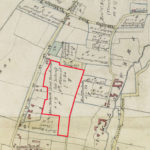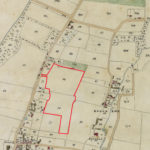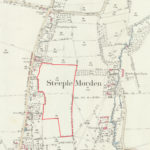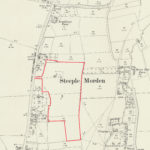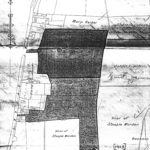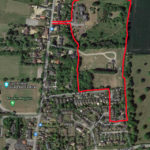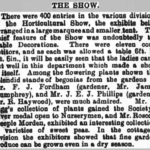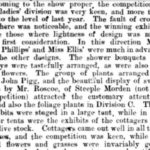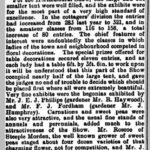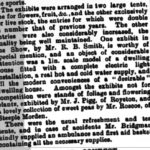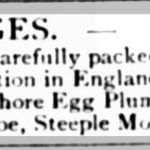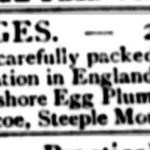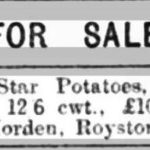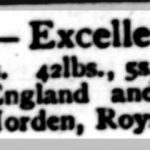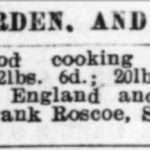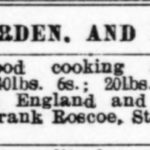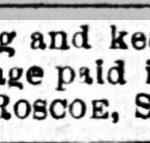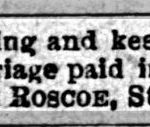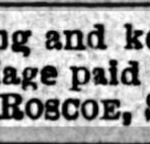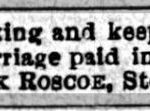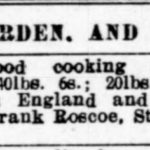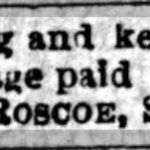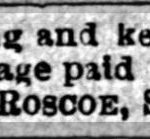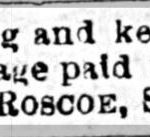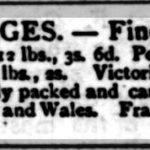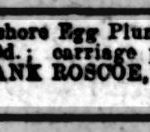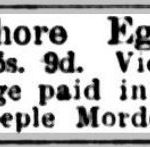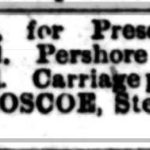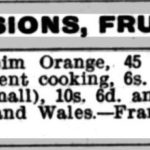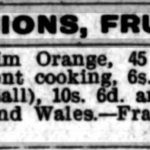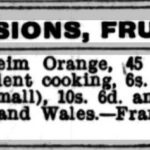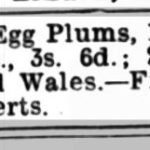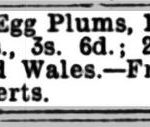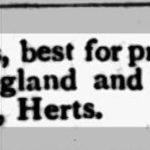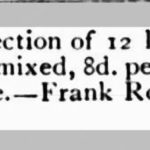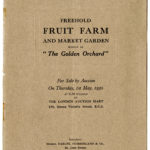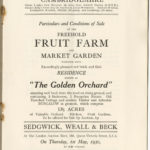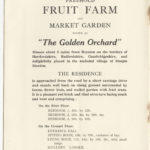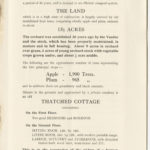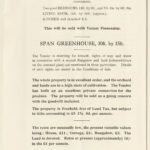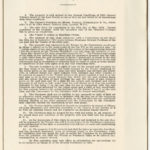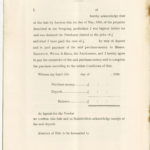The Golden Orchard
The Beginnings
A remarkable story of horticultural endeavour, begun in the midst of the deepest and longest agricultural depression this country has known. The horticultural entrepreneur, was Francis (Frank) Aikin Roscoe, who was of a family of English origins, although he was born at Ross Bay, Canada in 1869. He came to England in 1879, eventually arriving in Steeple Morden in September 1894. It appears that he had met Ernest Oswald Fordham of Odsey, through Ernest’s wife Emily Mary Foster of Edgbaston, as the Roscoe family lived close to the Foster family home in Edgbaston and it is likely the families moved in similar social circles. Ernest and Francis became friends.
Frank, as he was usually known, trained in fruit growing at Malvern and having completed his training was invited to Steeple Morden by Ernest, where the Fordham family owned two blocks of land off Hay Street in an area known as The Croft or Craft. The northern block of 7a 3r 1p was bought by Montague Edward Fordham at the Wimpole Estate sale in 1892 and the southern block of 6a 1r 24p had been bought in 1878 by Montague’s father Herbert, from the Executors of Thomas Strickland and after Herbert’s death in 1892 was bought from his Estate by Montague, who was a solicitor in Birmingham.
On 29 September 1894, Montague Fordham leased both blocks of land totalling 14a 0r 24p to Frank Roscoe, who began establishing an orchard and market garden. His endeavours brought him some commercial success and on 30 September 1903, Roscoe was able to buy the land in its entirety from Fordham. Included with the land was the cottage known today as Two Trees. Roscoe was helped in his purchase with a mortgage from Percy Scott Worthington and Ernest Oswald Fordham. The property remained mortgaged until well into the 1930s, although the lenders changed from time to time. Fruit growing and market gardening had not made Frank Roscoe that wealthy it seems.
The property was known as The Golden Orchard by at least 1906 and probably earlier.
Frank planted mainly apple and plum trees and when he sold up in 1930 there were 1900 apple trees and 965 plum trees. He also grew gooseberries and blackcurrants and was a noted grower of sweet peas and potatoes.
Advertising to promote trade
A number of press advertisements have been found, placed by Roscoe over the period 1904-1922. He favoured short advertisements in the classified columns of popular magazines of the day, such as Tablet, Common Cause, Clarion and Votes for Women. He also “blitzed” the north-west of England with advertisements in the St Helens Examiner, Widnes Examiner and Runcorn Examiner in 1906. The same year he used also the Surrey Mirror.
For apples described as excellent cookers and dessert, although no variety, he offered 40lb or 42lb for 6s and 20lb for 3s 6d. These 1905 prices remained the same for unspecified variety apples in 1915, when Blenheim Orange were 45lb for 8s 6d and 21lb for 4s 6d and Cox’s Orange Pippin (small) were 10 stone for 6s and 5 stone for 3s.
He offered genuine Greengages at 24lb for 7s in 1904 and in 1915 at the lower price of 6s. Pershore Egg plums for 24lbs were 4s in 1904, 3s 6d in 1907, 4s 6d in 1911, 6s 6d in 1912, then down to 4s 6d in 1915, with slight rise to 5s in 1916 and 1922. Victoria plums were 24lb for 5s 6d in 1907, 8s 6d in 1912! but down to 6s in 1916. All prices were carriage paid.
Price changes seem to be what you would expect with fluctuations in harvest and market demand, although the First World War appears to be a time of generally lower prices.
In the local newspaper, The Royston Crow, in 1905 Roscoe offered Northern Star potatoes for sale at £10 a ton. Today in 2021 the average price of potatoes is £200 a ton ex farm, although depending on variety and quality prices are higher or lower. Selling by the ton suggests he was growing them in some quantity and typical yields would be 10 to 20 tons per acre.
There are newspaper reports describing the fine displays of sweet peas that Roscoe mounted (not for competition) at the Royston Show in 1901, 1902 and 1903. In 1923 he advertised sweet pea seed for sale
With the size of the orchard and market garden, one has to assume that most of his sales were through the various markets and wholesalers, with perhaps some direct to retailers? The direct sales through advertising were presumably a small part of the operation and it would be wonderful to know how swayed the residents of St Helens, Widnes and Warrington to buy with a few classified lines in their local paper.
Living Accommodation
Neither block of land had any buildings showing on the 1808-1817 or 1839 maps and even as late as the 1887 edition of the 25 inch Ordnance Survey, surveyed 1886, there was no dwelling depicted. However, the 1901 revision did show a dwelling towards the top of the northern block and s smaller property at northern edge of the southern block. They appeared again on the 1903 edition of the same OS map.
These can be assumed to be the “residence in red brick and tiled, facing south and west” and “old thatched cottage” two up and two down, as described in the 1930 Sale Particulars. The evidence from the maps suggests that Frank Roscoe, perhaps with support from the Fordhams, had the red brick residence erected as his home.
Two other buildings are shown on the southern block in the 1930 Particulars and in her will made February 1925 Gertrude Kate Roscoe describes “my two bungalows Perivale and Sleepy Hollow, both on The Golden Orchard Estate, Steeple Morden to my beloved husband Francis Aiken [sic] Roscoe”. She directed that half the rent received each year for the two properties should be paid to her brother Ernest William Huson. Other mention of those two bungalow names has yet to be found.
The red brick residence, likely built between 1894-1901 was demolished in the late 1938-39 and replaced by a substantial and fashionable dwelling, which was initially The Orchards and in time became The White House. Later this became the site of the modern Woodland Grange at 66 Hay Street. The thatched cottage was allowed to decay and disappeared within living memory. Both bungalows appear to have been demolished?
The Golden Orchard Sold
After 36 years of toil, Frank decided it was time to retire and the property was put up for auction on 1 May 1930. Frank retained part of the southern block of Golden Orchard, with a bungalow, which he named Croftlands.
On the maps below the red lines shows the extent of The Golden Orchard.
The new owners Walter Leslie Bolt and his wife Florence Isabel Bolt are recorded from 1932 as fruit growers, although they appear to have been gone by 1935. Clifford Tom Berrett and wife Rebecca Mary were resident at The Golden Orchard by 1936 and themselves gone by late 1938.
At some point ,Charles Henry Rigg a stockbroker with a London home in Hampstead came on the scene. As early as 1933 his 13 year old daughter described herself as of Steeple Morden, although it is unclear which house they lived in. By 1934 Charles Rigg at least some of the northern portion of Golden Orchard. He was noted rose grower and roses gradually took land from the vegetables and fruit trees.
Frank Roscoe sold Two Trees to Lois Adah Rigg, the wife of Charles Henry in 1934 and in 1943 sold her the remaining southern block of land, presumably staying as tenant at his bungalow Croftlands. In October 1946 Lois Rigg sold the southernmost close of land to Bernard Gentle and this was later to become part of Craft Way and the local authority housing site to the south.
The Golden Orchard name lives on for the block of land and residence, which today is 60 Hay Street.
The Origins of the Land Holding
The Croft or Craft (and sometimes in the plural) was an open arable field, in which many different owners held strips of land. It lay between Hay Street and Bogs Gap and Brook End and was small compared with the other open fields in the parish. At Inclosure in 1816 it was assembled into larger holdings, including 7a 2r 34 as a freehold allotment to the Earl of Hardwicke and 6a 1r 9p as a freehold allotment to John Mabbott. They are shown on the Enclosure Map below within the red line. Little had changed when the Tithe Map was prepared in 1839 and it was these two plots that were later combined under the ownership of Montague Fordham and leased to Frank Roscoe to become The Golden Orchard.
Click on any image below to view. Click again to enlarge. Drag to view whole image.
Maps and Plans
Press Reports and Advertising by Roscoe
Sale Particulars 1930
Sale Particulars for The Golden Orchard, Steeple Morden,1 May 1930
Conditions of Sale – Extract of significant conditions
4 The Vendor is selling as Beneficial Owner
5 The abstract of title shall commence with a Conveyance of sale dated the 30th September 1903 made between Montague Edward Fordham of the one part and the Vendor of the other part
6 The property was conveyed to the Vendor by the Conveyance mentioned in cause 5 subject as to the lands south of the line D E on the annexed plan “to certain rights of way and other rights for the neighbouring property late the property of Thomas Strickland over and upon the entrance or way from Hay Street to the same properties respectively.” The Vendor is only aware of the right of way between Hay Street and the properties aforesaid and the right to take water from the well mentioned in clause 7 hereof and of access to the said well for that purpose. The sale is made subject to the rights referred to in the said Conveyance and no requisition or objection shall be made or taken as to the nature or subsistence of any such rights or in any way respecting them.
7 The sale is subject to (i) a right of way for the owners and occupiers for the time being of the bungalow and lands retained by the Vendor (indicated by the colour green on the annexed plan) and their families and servants and others with or without horses and other animals carts carriages and other vehicles to be reserved or granted to the Vendor between the points marked A and B on the said plan so as to give access between Hay Street and the said retained land and also across the strip of land dividing the said two pieces of land coloured green on the said plan and (ii) a right for the owners and occupiers and others aforesaid at all times to take water from the well situate at or near the position indicated by the letter C on the said plan for use in connection with the said bungalow and land indicated by the colour green and a right of way accordingly for that purpose between the points indicated by the letters B and C on the said plan, and the Conveyance to the Purchaser shall be framed accordingly.
[Note: these are the only conditions with specific information. Unfortunately, the copy of the plan is in black and white and the area marked green is not shown.]
Last Updated on February 19, 2025

